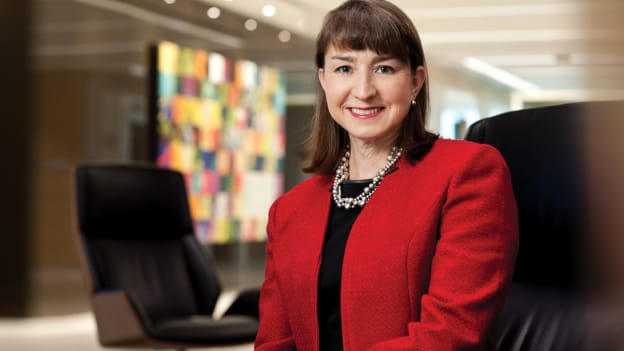To have diversity, there must first be a strategic imperative: Deloitte's Elizabeth Faber

In September 2018, Deloitte Asia Pacific, when it was formed, created a new role for the specific purpose of overseeing all people and partner matters in the entire region, from Australia and New Zealand to Southeast Asia, China, Japan and Taiwan: the Chief Talent Officer. The firm appointed one of its partners, Elizabeth Faber, to the position, with a clear mandate: create a more diverse and inclusive culture across APAC.
Faber, who has spent her entire career in various roles and geographies with Deloitte, is a long-time advocate of diversity and inclusion and has hit the ground running in the new role. One of her earliest initiatives as Chief Talent Officer was to create an AP Talent strategy to enable one of the key firmwide strategic priorities to create a culture of inclusion and growth. This proved so effective that in mid-2019, less than a year after her appointment, Faber was awarded the prestigious Diversity Champion Award at Campaign’s third Women Leading Change Awards. She also made it to the HRD Asia Hot List 2020 as a leader who has advanced the standing of HR in her organization.
People Matters asked Faber about her thoughts on how Deloitte’s D&I practices have played out to date, and some of the factors that help organizations succeed with an inclusive strategy.
Here are some excerpts from the conversation.
What are your thoughts on the D&I landscape in the Asia Pacific region? How has it evolved over the years, and are things where they should reasonably be?
When I think about the evolution of an inclusive strategy, I see it as having moved from an approach that is more compliance-based, to one that is more HR-led, and finally to a leader-driven strategic focus. Across the region, firms will be at different levels on that continuum. Some are more HR-led: their initiatives and projects to create diversity are driven mainly by the talent function. Some are more leader-driven, where it’s clear that the CEO has identified diversity as a strategic priority and is keen on having a more inclusive culture and diverse workforce.
Deloitte Asia Pacific is more on the leader-driven end of the continuum, where we have recognized diversity as a strategic imperative. Without having that strategic intent around a culture of inclusion, the shift [towards greater diversity] won’t happen. And we’re very clear that this is the culture we want, where everyone can succeed.
Do you factor in an inclusive mindset when you do your hiring: is it something that people are ready for?
We are very focused on helping our existing employees and partners develop an inclusive mindset. We make broad efforts to help them understand what we mean by an inclusive mindset: we have training, workshops, initiatives to educate them about the concept. When it comes to the recruitment function, though, while that certainly plays a major role in ensuring that we have a diverse workforce, it’s a little harder to test for an inclusive mindset at that stage.
Certainly, we would not hire someone who does align with our culture and values, so in that sense, it is a deal-breaker. We do look very carefully at our pipeline, to ensure “pipeline parity” at all levels, so that the incoming gender mix, culture mix, or other indicators are representative of what we aspire to have in the firm.
We, at Deloitte, look at the overall percentage of women in leadership roles including executives and board members, and we track the gender balance of our intake at different levels: new recruits, experienced hires, and partner hires
You've just launched a Panel Promise initiative that aims to achieve fair and balanced representation on panels at conferences and forums, and you've even set specific numbers: 40 percent men, 40 percent women, possibly and 20 percent men, women or other under-represented groups. While it's still early days, how is this playing out so far?
It is playing out very well. Our leaders across AP have signed off on this initiative: we have the signatures of executives and board members from different geographies, committing to adhere to the targets, and that is making a difference to the numbers internally. We’re also starting to get a lot of external traction.
As an example, I’ve been invited to two conferences where I had the opportunity to work with the organizers on the question of how to improve representation, and I was able to help them source speakers. For one conference, the topic revolved around the future of the financial services sector and the accounting profession, and the speakers were all male. I respectfully challenged them on that: how can you credibly talk about the future without having representation of the people who will actually be part of the future?
It goes two ways. At another conference, on women in leadership, all the speakers were women. But you can’t move the needle on women in leadership without involving the perspective and sponsorship of the men.
This is so important, because if you do not have diversity of thought, you will not have diversity of discussion, of dialogue, of debate.
Could you share your experience with gaining organizational buy-in and ownership towards driving D&I initiatives?
The point around having gender representation, or really any kind of representation, is that there is a business case for it. We’re promoting women in leadership, for example, because it has been proven that having a more diverse workforce at senior levels—executive level, board level, and in our case, partner level—does benefit business performance.
Most leaders respond well to the language of the business case; they see the benefit of having more diverse voices. That’s how I counter challenges towards D&I: by bringing the discussion back towards performance and outcomes.
What kind of metrics do you usually look at when evaluating D&I initiatives?
Deloitte is a partnership, so one of our key metrics is the percentage of women partners. We also look at the overall percentage of women in leadership roles including executives and board members, and we track the gender balance of our intake at different levels: new recruits, experienced hires, and partner hires. We track promotion pipelines, especially for manager and director roles, as these lead directly to our longer-term goal for the percentage of women partners. We run surveys to hear what our people are saying about D&I, to understand their mindset. All these metrics and others go into a scorecard that we match up with our goals every six months at a global level starting from the top. We’ve been tracking them for about a year and a half now.
When we first began measuring diversity and inclusion metrics, we calculated, based on the practices then in place, how long it would take for Deloitte to achieve gender parity at partner level. And the number was just not acceptable. After that, we launched a global strategy called ALL IN, which focuses on growing women leadership, and the timeline has become much better. It’s still not great and we will continue to work on it, but you can definitely see an improvement.
What is your advice for leaders who want to build scalable D&I initiatives?
I am a fan of starting small, testing and learning before scaling. Starting small can also mean starting with the biggest population, because scalability varies by local context. When you look at the Asia Pacific, there are so many different diversity profiles across the geographies: some groups are more relevant in some markets than others. There are definitely other under-represented groups that have a higher priority in different markets, be it cultural diversity, LGBTI, or other aspects. But something like cultural diversity is more difficult to scale globally. This is why we focus on women: gender diversity applies to all the markets, and improving gender diversity can pave the way for other under-represented groups to follow.














